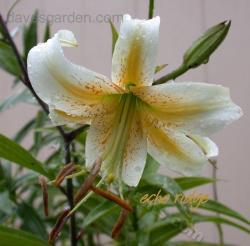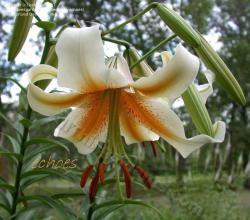Mar 5, 2007
Lily classifications
Asiatic Hybrids – Horticultural Division 1
The asiatic hybrids are among the earliest to bloom, and also the easiest of lilies to grow! You can plant these lilies almost anywhere…especially in brightest sunshine with lots of gay garden plants for company. They have the broadest color range of any division, including whites, pinks, plums, yellows, oranges, and reds. Their flowers can be upfacing, outfacing, or pendant, and generally are not scented.
Technically speaking, Division 1 lilies are hybrids derived from such species as L. tigrinum, L. cernuum, L. davidii, L. maximowiczii, L.x macultum, L. x hollandicum, L amabile, L. pumilum, L. concolor, and L. bulbiferum.
Martagon Hybrids – Horticultural Division 2
Along with the earliest of the asiatics, blooms another entirely different group called the martagons, or martagons hansonii hybrids. These are tall lilies with many little down-facing flowers and whorled leaves. Martagons appreciate some shade, and are quite decorative in the woodland garden. Though it might take them a year to adjust to a new garden, once established, the martagons will thrive for years. Yellow, white, pink, lavender, light orange, deep dark red are the colors most often seen, often with whimsical freckles and spots.
Division 2 lilies include hybrids derived from such species as L Martagon, L hansonii, L medeoloides, and L tsingtauense.
Candidum Hybrids – Horticultural Division 3
Division 3 includes hybrids derived from such as L candidum, L chalcedonicum, L monadelphum, and other related European species, but excluding L Martagon.This division includes very few entries, and they are not easily found in commerce.
American Hybrids – Horticultural Division 4
There are many native lilies in North America…and the western species have been used to create some very beautiful and graceful lilies. The bulbs are unique…made up of little jointed scales, and the blooms like bouncy bright balloons on swinging curved pedicels. Division 4 lilies can be challenging outside of the western United States and Canada, but their unique beauty certainly makes them worth trying. With growing conditions that suit them, which includes a cool light soil and dappled shade, they can rapidly make impressive clumps.
Division 4 includes hybrids derived from North American species, such as L pardalinum, L humboldtii, L kelloggii, and L parryii.
Longiflorum Hybrids – Horticultural Division 5
This division includes hybrids derived from L longiflorum and L formosanum. These hybrids are generally elegant white trumpets, easily raised from seed, but not particularly hardy in the garden.
Trumpet and Aurelian Hybrids – Horticultural Division 6
To some people, no lily is a real lily unless it is a trumpet! Who can deny that a trumpet lily is like no other plant in the garden…tall, stately, serene and magnificent…with huge waxy flowers full of fragrance? And colors…not only pure glistening white, but bright gold, yellow, chartreuse, pink, plum, and apricot are available…some with backs of brown or purple or iridescent green!
Aurelians are hybrids that include Lilium henryi in their ancestry. L. henryi is a rugged species that has tightly recurved orange or yellow flowers, giving the aurelians a wide range of flower shapes and colors.
Trumpets and aurelians bloom in mid to late season, and their huge flower heads may require staking. They may also require a mulch in cold winter areas, and some protection from late spring frosts… but these little services are amply repaid by the long season of spectacular, fragrant bloom.
Division 6 includes hybrids derived from L luecanthum, L regale, L sargentiae, L sulphureum, and L henryi.
Oriental Hybrids – Horticultural Division 7
Lilies of this exotic group are not among the easiest to grow, particularly in hot summer areas. But you will try them…we know! Often called “Stargazers “, these lilies have huge flowers with wonderful fragrance… in shades of white, pink, salmon, and crimson. Give them partial shade, plenty of water, humus rich soil that is slightly acid, and mulch for a cool root run.
Division 7 includes hybrids derived from L auratum, L speciosum, L nobilissimum, L rubellum, L alexandrae, and L japonicum.
Miscellaneous Hybrids – Horticultural Division 8
Division 8 includes hybrids that are not provided for in any previous division, including crosses between divisions. “Orienpets”, hybrids between Division 7 (oriental) and Division 6 (trumpet & aurelian) lilies are a prominent example, and you will surely want to include them in your garden. They combine the beautiful flower shape and color of the orientals …with the ruggedness and dependability of trumpets and aurelians. They are much better suited to hot summer areas than the orientals, and …more resistant to winter cold.
Species – Horticultural Division 9
Species lilies are wild lilies. Native lilies occur in North America, Europe, and especially Asia…Japan, China, Burma, & India. It is from these wild lilies that breeders have created their magnificent hybrids for our gardens. Species lilies oftentimes possess a delicate charm that appeals to many people, and many of the species make fine garden plants…while others are a real challenge to grow.
_____________________________________________________________________________________________________________________________
Initial Comments:
Lily classification
The Seventeenth Supplement to the International Lily Register (published in 1999) introduced a system of dual subdivisions for every newly registered lily. Prior to this publication, subdivisions had only been used in some of the horticultural divisions into which the genus has been split and the characters involved varied with the division created.
Now, both flower habit ((a) up-, (b) out- or (c) down-facing) and flower form ((a) trumpet, (b) bowl, (c) flat or (d) recurved) are indicated for each entry when this information has been supplied by the registrant. The existing lettering is retained with flower habit given first, separated from flower form by a forward slash mark (/). Thus the entry for 1(b/c) 'Aloft' represents an Asiatic Lily (Division 1) with out-facing, flat-faced flowers.
At present, there is no intention to systematically revise all existing Register entries to include a dual subdivision but when the relevant information is available, it will be added to the record.
It is not a requirement that dual submission be used at all times. The way in which the information is presented means that, where for a particular purpose it is necessary, one or both can be ignored. Their inclusion, however, together with the division number, helps to present, in an abbreviated form, a quick 'picture' of the flower concerned. For a full account of any plant, it is necessary to refer to the description.
http://www.rhs.org.uk/Plants/r...
______________________________________________________________________________________________________________________________
Bright Star, Lady Alice and White Henryi
VI (d) Bright Star clone
Parentage: Selection from Aurelian Hybrids
Hybridizer: R:&N: J.deGraaff. OBF cat. 1959.
Description: Ivory white outside, apricot orange star inside; petal tips recurved. Stems 1.0-1.5m. July. C*1966.
Photo Available Photo Available
Comments
On 6 September 2006 Calvin Helsley wrote:
The original 'Bright Star' is a clone. Bulbs currently available are a seed grown strain of very similar lilies.
VI (/d) Lady Alice clone
Parentage: Unknown
Hybridizer: R & N : De Jong Lelies, c.1971 REG: IRA, 1998.
Description: Apricot orange, tips fading to white; outside pale apricot with yellowish ribs; spots scarce, small, cinnamon; papillae present in throat; nectaries green. Fls turk's-cap-shaped; petals 90 x 34mm, strongly recurved. Lvs 125 x 20mm, glossy green. Stems 1.1m, dotted dark violet brown. July.
VI (d) White Henryi clone
Parentage: L. henryi x L. leucanthum var centifolium
Hybridizer: R:&N: L.Woodriff, c.1945.
Description: White, deep orange throat, red speckling of minute papillae. Fls scented; petals with reflexed tips. Stems 1.5m. July.
Lady Alice

White henryi

Discussions:
| Thread Title | Last Reply | Replies |
|---|---|---|
| The Horticultural Classification of Lilies by echoes | Feb 15, 2016 10:28 PM | 0 |
Post a new thread about this blog entry: